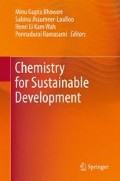Abstract
We have carried out a detailed computational study on the neutral-neutral direct hydroamination reactions between various substituted ethylene derivatives with ammonia, using the density functional theory based B3LYP/6-31++G(2df,2p) level of theory. Analysis of the potential energy surfaces for all these reactions shows that in all these cases thermodynamically the Markovnikov product is more stable than the anti-Markovnikov product. Analysis of the transition states for all these reactions shows that kinetically in some cases the Markovnikov product is preferable whereas other cases the anti-Markovnikov product is preferable. This gives a clear indication on how to control the selectivity in these reactions by mere alteration of the substituent. We observed that, in the case of ethylene with an electron withdrawing substituent (i.e. CH2=CH–NO2) reacting with ammonia, the barrier height is reduced by approximately 70 kJ/mol and at the same time the anti-Markovnikov product is preferred kinetically. This situation clearly mimics the general catalytic hydroamination reaction where the ethylene is being activated by the catalyst. Also, this suggests that a stronger electron withdrawing group than −NO2 will possibly be able to reduce the barrier height further and ultimately a non-catalytic neutral-neutral direct hydroamination reaction will be physically attainable.
Access this chapter
Tax calculation will be finalised at checkout
Purchases are for personal use only
References
Pohlki C, Doye S (2003) The catalytic hydroamination of alkynes. Chem Soc Rev 32:104–114
Muller TE, Beller M (1998) Metal-initiated amination of alkenes and alkynes. Chem Rev 98:675–803
Brunet JJ, Neibecker D, Philippot K (1993) Rhodium-mediated 100% regioselective oxidative hydroamination of α-Olefins. Tetrahedron Lett 34:3877–3880
Trost BM (1991) The atom economy: a search for synthetic efficiency. Science 254:1471–1477
Roundhill DM (1997) Homogeneously catalyzed amination of alkenes. Catal Today 37: 155–165
Senn HM, Blochl PE, Togni A (2000) Toward an alkene hydroamination catalyst: static and dynamic ab initio DFT studies. J Am Chem Soc 122:4098–4107
Taube R (1996) Reaction with nitrogen compounds: hydroamination. In: Cornils B, Herrmann WA (eds) Applied homogeneous catalysis with organometallic compounds, vol 1. VCH, Weinheim, pp 507–520
Heilen G, Mercker HJ, Frank D, Reck RA, Jackh R (1985) Amines, aliphatic. In: Gerhartz W (ed) Ullmann’s encyclopedia of industrial chemistry, vol A2. VCH, Weinheim, pp 1–56
Gagne MR, Stern CL, Marks TJ (1992) Organolanthanide-catalyzed hydroamination. A kinetic, mechanistic, and diastereoselectivity study of the cyclization of N-unprotected amino Olefins. J Am Chem Soc 114:275–294
Roundhill DM (1992) Transition metal and enzyme catalyzed reactions involving reactions with ammonia and amines. Chem Rev 92:1–25
Brunet JJ, Neibecker D, Niedercorn F (1989) Functionalisation of alkenes: catalytic amination of monoolefins. J Mol Catal 49:235–259
Dorta R, Egli P, Zurcher F, Togni A (1997) The [IrCl(Diphosphine)]2/Fluoride System. Developing catalytic asymmetric olefin hydroamination. J Am Chem Soc 119:10857–10858
Gase MB, Lattes A, Perie JJ (1983) Amination of alkenes. Tetrahedron 39:703–731
Coulson DR (1971) Catalytic addition of secondary amines to ethylene. Tetrahedron Lett 12:429–430
Hamann T, Bohler E, Swiderek P (2009) Angew Chem Int Ed (English) 48:4643–4645
Sitha S, Jewell LL (2010) Non-catalytic hydroamination of alkenes: a computational study. Tetrahedron 66:3030–3036
McMurry JE (2008) Organic chemistry, 7th edn. Brookscole, Pacific Grove
Frisch MJ, Trucks GW, Schlegel HB, Scuseria GE, Robb MA, Cheeseman JR, Montgomery JA Jr, Vreven T, Kudin KN, Burant JC, Millam JM, Iyengar SS, Tomasi J, Barone V, Mennucci B, Cossi M, Scalmani G, Rega N, Petersson GA, Nakatsuji H, Hada M, Ehara M, Toyota K, Fukuda R, Hasegawa J, Ishida M, Nakajima T, Honda Y, Kitao O, Nakai H, Klene M, Li X, Knox JE, Hratchian HP, Cross JB, Adamo C, Jaramillo J, Gomperts R, Stratmann RE, Yazyev O, Austin AJ, Cammi R, Pomelli C, Ochterski JW, Ayala PY, Morokuma K, Voth GA, Salvador P, Dannenberg JJ, Zakrzewski VG, Dapprich S, Daniels AD, Strain MC, Farkas O, Malick DK, Rabuck AD, Raghavachari K, Foresman JB, Ortiz JV, Cui Q, Baboul AG, Clifford S, Cioslowski J, Stefanov BB, Liu G, Liashenko A, Piskorz P, Komaromi I, Martin RL, Fox DJ, Keith T, Al-Laham MA, Peng CY, Nanayakkara A, Challacombe M, Gill PMW, Johnson B, Chen W, Wong MW, Gonzalez C, Pople JA (2004) Gaussian 03, Revision C.01. Gaussian, Inc., Wallingford
Beller M, Trauthwein H, Eichberger M, Breindl C, Muller TE, Zapf A (1998) New cationic rhodium-amine complexes and their implication in the catalytic anti-Markovnikov oxidative amination of styrene. J Organomet Chem 566:277–285
Beller M, Trauthwein H, Eichberger M, Breindl C, Herwig J, Muller TE, Thiel OR (1999) The first rhodium-catalyzed anti-Markovnikov hydroamination: studies on hydroamination and oxidative amination of aromatic olefins. Chem A Eur J 5:1306–1319
Acknowledgements
SS thanks Claude-Leon foundation of South Africa for the postdoctoral fellowship. This material is based on work supported by the National Research Foundation, South Africa. This publication was made possible (in part) by a grant from the Carnegie Corporation of New York. The statements made and views expressed are, however, solely the responsibility of the author
Author information
Authors and Affiliations
Corresponding author
Editor information
Editors and Affiliations
Rights and permissions
Copyright information
© 2012 Springer Science+Business Media B.V.
About this chapter
Cite this chapter
Sitha, S., Jewell, L.L. (2012). Neutral-Neutral Direct Hydroamination Reactions of Substituted Alkenes: A Computational Study on the Markovnikov Selection Rule. In: Gupta Bhowon, M., Jhaumeer-Laulloo, S., Li Kam Wah, H., Ramasami, P. (eds) Chemistry for Sustainable Development. Springer, Dordrecht. https://doi.org/10.1007/978-90-481-8650-1_23
Download citation
DOI: https://doi.org/10.1007/978-90-481-8650-1_23
Published:
Publisher Name: Springer, Dordrecht
Print ISBN: 978-90-481-8649-5
Online ISBN: 978-90-481-8650-1
eBook Packages: Chemistry and Materials ScienceChemistry and Material Science (R0)

